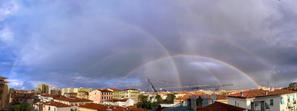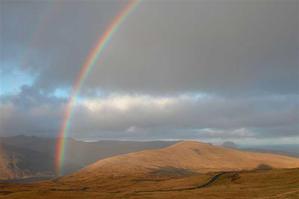Glossary term: Arc-en-ciel
Description: On appelle arc-en-ciel l'immense arc aux bandes concentriques de couleur violette, indigo, bleue, verte, jaune, orange et rouge, qui s'étend dans le ciel et qui est généralement visible après une pluie. Lorsqu'un observateur voit un arc-en-ciel, le soleil est dans son dos. Un arc-en-ciel se produit parce que les petites gouttelettes d'eau dans l'air décomposent la lumière blanche du soleil en un spectre de couleurs par un processus appelé dispersion dû à la réfraction ; ce processus est similaire au fonctionnement d'un prisme. Dans un arc-en-ciel normal, la lumière est réfléchie une fois dans les gouttelettes d'eau et dispersée par réfraction.
On peut parfois observer deux arcs-en-ciel imbriqués, où les couleurs du deuxième arc-en-ciel sont dans l'ordre inverse. L'arc-en-ciel intérieur, plus lumineux, est appelé arc-en-ciel primaire, tandis que l'arc-en-ciel extérieur, moins lumineux, est appelé arc-en-ciel secondaire. Ce phénomène de double arc-en-ciel est relativement rare. L'arc-en-ciel secondaire se produit lorsque la lumière subit une double réflexion au sein des gouttelettes d'eau, en plus de la réfraction.
Related Terms:
See this term in other languages
Term and definition status: The original definition of this term in English have been approved by a research astronomer and a teacher The translation of this term and its definition is still awaiting approval
The OAE Multilingual Glossary is a project of the IAU Office of Astronomy for Education (OAE) in collaboration with the IAU Office of Astronomy Outreach (OAO). The terms and definitions were chosen, written and reviewed by a collective effort from the OAE, the OAE Centers and Nodes, the OAE National Astronomy Education Coordinators (NAECs) and other volunteers. You can find a full list of credits here. All glossary terms and their definitions are released under a Creative Commons CC BY-4.0 license and should be credited to "IAU OAE".
If you notice a factual or translation error in this glossary term or definition then please get in touch.
Related Media
24 Hours of Rainbow
Credit: Fabrizio Guasconi/IAU OAE (CC BY 4.0)
License: CC-BY-4.0 Creative Commons Attribution 4.0 International (CC BY 4.0) icons
Related Activities
Reading the Rainbow
astroEDU educational activity (links to astroEDU website) Description: By understanding how rainbows work, you can discover about light and its properties, learning about stars, nebulae, galaxies, and our Universe.
License: CC-BY-4.0 Creative Commons Attribution 4.0 International (CC BY 4.0) icons
Age Ranges:
14-16
, 16-19
, 19+
Education Level:
Informal
, Middle School
, Secondary
, University
Areas of Learning:
Interactive Lecture
, Observation based
, Social Research
Costs:
Low Cost
Duration:
1 hour 30 mins
Group Size:
Group
Skills:
Analysing and interpreting data
, Asking questions
, Engaging in argument from evidence










